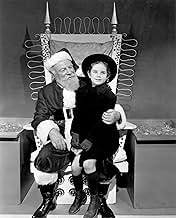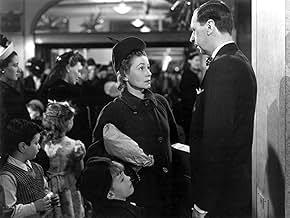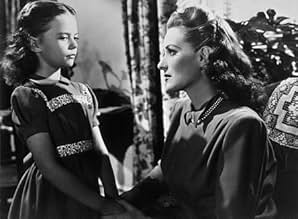After a divorced New York mother hires a nice old man to play Santa Claus at Macy's, she is startled by his claim to be the genuine article. When his sanity is questioned, a lawyer defends h... Read allAfter a divorced New York mother hires a nice old man to play Santa Claus at Macy's, she is startled by his claim to be the genuine article. When his sanity is questioned, a lawyer defends him in court by arguing that he's not mistaken.After a divorced New York mother hires a nice old man to play Santa Claus at Macy's, she is startled by his claim to be the genuine article. When his sanity is questioned, a lawyer defends him in court by arguing that he's not mistaken.
- Won 3 Oscars
- 10 wins & 1 nomination total
- Mr. R.H. Macy
- (uncredited)
- Courtroom Spectator
- (uncredited)
- Mrs. Shellhammer
- (uncredited)
- Courtroom Spectator
- (uncredited)
- Judge's Clerk
- (uncredited)
- Child on Santa's Lap
- (uncredited)
- Secretary
- (uncredited)
- Department Store Head
- (uncredited)
- Director
- Writers
- All cast & crew
- Production, box office & more at IMDbPro
Featured reviews
I love movies like this for the insight they provide into the customs of a lost era. Watch the clothing - everybody is so dressed up! - women in dresses, gloves, and hats, men in hats and suits. Notice that when O'Hara enters a room filled with Macy's executives, even though they are the bosses and she is lower management, they all stand up instantly.
The social satire, most on display in the courtroom scenes, also is very 1940s. Apparently audiences of that era took a kind of genial corruption in the judicial system in stride. Business leaders, like "Mr. Macy" were expected to be sharp and profit-oriented, but also decent people like the rest of us. It's a much more nuanced view than the "businessman as criminal villain" so common in today's movies.
The character played by Maureen O'Hara probably needs explanation for modern viewers. Late 1940s audiences knew that the social and economic situation of a divorced working woman with a child was much more precarious than it is now. Divorce was still somewhat shocking - this is brought out neatly in the movie when her would-be lover does a double take when he learns from her daughter about the divorce - he probably had assumed she was a war widow. Divorced moms were still rare in the middle classes. Society universally agreed that women should stay home to raise their children. Economically, women in management positions were still very rare, couldn't expect promotion, and were last hired, first fired. I think O'Hara's performance brings out these qualities in a way that the audience of the 1940s would have understood easily. The character's stiffness, fear of losing control, and anxiety about her job make a great deal of sense. It would have been nice to see a few scenes showing her loosening up, perhaps at dinner with her boyfriend; no doubt those got left on the cutting room floor.
I really like the scene where Santa talks to the little Dutch orphan. First, this scene also must have resonated with the audience; in 1947 the western European countries had only started to recover from World War II, and probably many Americans were familiar with the idea of adopting a war orphan, just as many sent CARE packages. Second, by making Santa fluent in Dutch, the writer cleverly left the viewer thinking that hey, he might really be Santa Claus (isn't Santa Claus fluent in all languages)?
Some reviewers don't like the acting and think that modern actors are "better". I think the older actors aren't better or worse, just different. The audiences of the 1940s expected a certain style of acting, and the directors and actors gave that to them. Then as now, Hollywood paid top dollar and got very talented people, but like all of us they were shaped by their own time and place, more particularly the requirement to make movies that audiences would like. Move Maureen O'Hara to 2004, or Tom Cruise to 1947, and you'd see them acting in the style of that decade.
Gwenn's obvious sincerity makes him an ideal Santa Claus for Macy's and for us. He spreads the real meaning of Christmas around even has Macy's declaring a holiday truce with its rival Gimbel's. That's a part of Miracle on 34th Street that might be lost to viewers today. Gimbel's was Macy's big department store rival and it's flagship store in New York stood across 34th Street at the time. Gives a meaning to the title that is lost on today's audience.
But wiser and more sophisticated folks like the majority of us know there ain't no such thing as Santa Claus. Even Maureen O'Hara knows that and imparts it to her daughter Natalie Wood. Gwenn's just a kind old man in a white beard. But when his sanity is questioned, Gwenn's belief becomes a matter for the courts where Gwenn is ably defended by O'Hara's boyfriend, lawyer John Payne.
Like that other holiday classic It's A Wonderful Life, Christmas is never complete without seeing Miracle on 34th Street. Though New York has changed considerably since 1947 the year I made my earthly debut, the film has lost absolutely none of its charm.
Edmund Gwenn won the Best Supporting Actor of 1947 and in doing so, beat out his best friend, Finlay Currie, who was up that year for playing Magwitch in Great Expectations. The two had met in stock companies in their native Scotland and were friends right up to when Gwenn passed away in 1959. The Oscar was the high point of his career.
Maureen O'Hara in her memoirs says that Miracle on 34th Street holds a special place in her affections. In fact until Gwenn died, she had hopes of doing some kind of sequel. She bonded on stage with young Natalie Wood who later played her daughter in Father Was A Fullback also and kept in contact with her right up to her death in 1981.
Maureen also had a deep affection for John Payne who she made four films with and says was one of the nicest men in the world. One story she related was on the set of another film they made, Payne was served with divorce papers right on the set from his then wife, Anne Shirley. She said he broke down and cried like a baby. If it weren't for the fact she was married, she said she definitely could have gotten something going with Payne.
In the supporting cast note the presence of one grinch in the person of Porter Hall who played one of his patented nasty little meanies. His meddling and general misanthropy cause Gwenn to have that trial in the first place. Look for a bit role from Jack Albertson as the postal employee who inadvertently saves the day. Also making her film debut is Thelma Ritter as the mother of a child looking to meet Santa Claus, the one official Santa Claus, courtesy of Macy's Department Store.
Although Miracle on 34th Street has been remade several times over the years, this one is the genuine article. As genuine as the fact that Macy's has the official Santa Claus as certified by a higher authority.
One thing has always puzzled me though. How long did it take Edmund Gwenn to grow that beard for the part?
The movie begins with Kris Cringle (Edmund Gwen) walking by a store with a man setting up a display of reindeer and notices that they are not in order. Kris tells the man politely how to fix them in the right positions, but the man gives him a strange look and goes back to work. Kris Cringle believes himself to be Santa Claus although most everyone else thinks he is crazy. Even little Susan (Natalie Wood) thinks he is a fake and doesn't believe in any fairytales'. Her mother, Doris Walker (Maureen O'Hara), taught her that to believe in fairytales' is childish and impractical. Kris is later made a part of the Macy's parade when the Santa Claus that was supposed to be in the parade is found drunk. When asked if he had ever had any experience, Kris replied, `Many times.' Doris makes him the department store Santa Claus at Macy's where he tells many people that he is the real Santa Claus.
As more people find out about Kris Cringle calling himself Santa Claus', they get upset saying that no such person really exists. Many people took it more literally and said that it would be impossible for reindeer to fly or for anyone to live in the North Pole. He is forced to take a mental examination and the doctor convinces Doris that Kris is mentally ill after he gets in a fight. Kris is arrested and taken to court and his lawyer is Mr. Gailey who starts to believe, along with Doris and Susan, the he actually is Santa Claus.
I thought that this was a really good holiday movie that focus on something that all of us as little kids went through- believing or not believing in Santa Claus. It even feels like I should believe in Santa after watching it. I thought that Edmund Gwen was a really good actor and perfect for his part. He played his role very innocently, which made him very believable as Santa Claus. Natalie Wood was a great actress who played very well the typical role of the cynical child. The acting and the plot was very well written. It was a very innocent movie that is entertaining for all types of audiences.
Gwenn, who played many solid character roles, gets the chance here to play a role for which he was ideally suited, and it works very well. O'Hara and Wood make a good pair to balance him out. The supporting cast gets some very good moments of their own, especially Gene Lockhart and William Frawley, whose scenes are entertaining while also offering some occasionally pointed commentary.
The style of the production is well-suited to the material, offering an innocently upbeat story without overdoing it on sentimentality. For all that this style of the production and acting are out of fashion, they are able to capture a theme like this in a worthwhile way that is simply not possible with the kind of false "sophistication" that permeates so many present-day movies.
That's not to say that this is some kind of masterpiece, which it is not and did not try to be. Instead, it's a light, enjoyable, positive movie that does make a worthwhile point or two. That kind of feature will always find an appreciative audience somewhere.
Frankly, in view of the fact that much of "Miracle" had already been shot on location in Macy's New York City store (to say nothing of the fact that studio heads of that era -- or any era, for that matter -- were notoriously prone not to take such financial risks), this "legend" is likely just so much "hype," otherwise known as "nonsense."
Thankfully, this is the only trace of phoniness attached to this jewel of a movie. "Miracle On 34th Street" is just that, in every sense of the word: a miracle.
Take a perfectly-crafted, thoughtful screenplay. Add an impeccable cast (from top-to-bottom, by the way; catch, just as one example, Thelma Ritter's uncredited turn as "Peter's Mother"). Throw into this mix an on-location "shoot" (along with Macy's, there's the store's actual 1946 Thanksgiving Parade, footage in a post office facility and a courthouse) which gives this film a nice sense of verisimilitude . . . just in case you're not already prepared (courtesy of Edmund Gwenn, in a totally-deserved Oscar-winning performance) to recapture your belief in Santa Claus.
"Miracle On 34th Street" is many things: a celebration of the Christmas spirit, a heartfelt plea against the "over-commercialism" (even in 1947)of Christmas, an examination of faith itself . . . just to name a few.
It works on every level. Every bit as well today, 54 years after its initial release, as then. Don't waste your time with the remakes -- both on TV as well as theatrical productions (and the less said about an abortive 1963 Broadway musical adaptation, "Here's Love," the better.)
Go for the original film. Go for the genuine article. Again and again and again.
Did you know
- TriviaIn the untranslated dialogue with the Dutch girl, Kris asks her what she wants for Christmas. She says she wants nothing, telling him she got her gift by being adopted by her new mother.
- GoofsKris claims that John Quincy Adams' Vice-President was Daniel D. Tompkins; actually, it was John C. Calhoun. Tompkins served under James Monroe from 1817-1825. The confusion likely occurred because Adams was the 6th President, whereas Tompkins was the 6th Vice-President, as Thomas Jefferson and James Madison had three Vice-Presidents between them.
- Quotes
Mr. Shellhammer: But... but maybe he's only a little crazy like painters or composers or... or some of those men in Washington.
- Crazy creditsThe film's credits do not contain the standard "All characters and events are fictional..." disclaimer, leaving many people to believe that this was a true story.
- Alternate versionsAlso available in two computer colorized versions. The film was first colorized in 1985 by Color Systems Technology, Inc. and again in 2006 by Legend Films using much-improved technology. Prints came with a disclaimer: "It has been altered without the participation of the principal director, screenwriter and other creators of the original film."
- ConnectionsFeatured in The Screen Writer (1950)
- SoundtracksJingle Bells
(1857) (uncredited)
Written by James Pierpont
Played at the announcement of the parade
Played occasionally in the score
Sung a cappella a bit by Percy Helton and later by Jack Albertson
- How long is Miracle on 34th Street?Powered by Alexa
Details
- Release date
- Country of origin
- Languages
- Also known as
- Le miracle de la 34ème rue
- Filming locations
- 24 Derby Road, Port Washington, Long Island, New York, USA(Susan's dream house)
- Production company
- See more company credits at IMDbPro
Box office
- Gross worldwide
- $3,851
- Runtime1 hour 36 minutes
- Color
- Aspect ratio
- 1.37 : 1
Contribute to this page








































